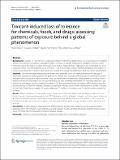| dc.contributor.author | Masri, Shahir | |
| dc.contributor.author | Miller, Claudia | |
| dc.contributor.author | Palmer, Raymond | |
| dc.contributor.author | Ashford, Nicholas A. | |
| dc.date.accessioned | 2021-08-13T14:20:09Z | |
| dc.date.available | 2021-08-13T14:20:09Z | |
| dc.date.issued | 2021 | |
| dc.identifier.uri | https://hdl.handle.net/1721.1/131176 | |
| dc.description.abstract | Background: Despite 15–36% of the U.S. population reporting Chemical Intolerances (CI) or sensitivity, the condition has been overlooked in medicine and public health. CI is characterized by multisystem symptoms and new-onset intolerances that develop in a subset of individuals following a major chemical exposure event or repeated low-level exposures. While Toxicant-Induced Loss of Tolerance (TILT) is a two-stage disease mechanism proposed to explain CI, less is known about the exposures that initiate the disease, than about the intolerances that have been documented.
Methods: We reviewed eight major exposure events that preceded onset of chemical intolerance in groups of individuals sharing the same exposure. Our goal was to identify the chemicals and/or groups of chemicals that were most pervasive during each exposure event as well as identify the concentrations of key chemicals involved in each exposure event and the proportions of exposed individuals who ultimately developed TILT following exposure. Case studies we selected for review included (1) workers at U.S. Environmental Protection Agency (EPA) headquarters during renovations; (2) Gulf War veterans; (3) pesticide exposure among casino workers; (4) exposure to aircraft oil fumes; (5) the World Trade Center tragedy; (6) surgical implants; (7) moldy environments; and (8) tunnel workers exposed to solvents.
Results: Mixed volatile and semi-volatile organic compounds (VOCs and SVOCs), followed by pesticides and combustion products were most prevalent across TILT initiation events. As a broader category, synthetic organic chemicals and their combustion products were the primary exposures associated with chemical intolerance. Such chemicals included pesticides, peroxides, nerve agents, anti-nerve agent drugs, lubricants and additives, xylene, benzene, and acetone.
Conclusion: A select group of exposures were predominant in several major initiating events, suggesting their potential role in TILT initiation. Such insights are useful to public health scientists, physicians, and policymakers seeking to minimize harmful exposures and prevent future disease. | en_US |
| dc.language.iso | en_US | en_US |
| dc.publisher | Environmental Sciences Europe | en_US |
| dc.rights | Attribution-NonCommercial-NoDerivs 3.0 United States | * |
| dc.rights.uri | http://creativecommons.org/licenses/by-nc-nd/3.0/us/ | * |
| dc.title | Toxicant‑induced loss of tolerance for chemicals, foods, and drugs: assessing patterns of exposure behind a global phenomenon | en_US |
| dc.type | Article | en_US |
| dc.identifier.citation | Masri, S., CS Miller, RF Palmer, and NA Ashford (2021) “Toxicant-Induced Loss of Tolerance for Chemicals, Foods and Drugs: Assessing Patterns of Exposure Behind a Global Phenomenon” Environmental Sciences Europe. 33:65 Available at: https://rdcu.be/cls7y | en_US |
